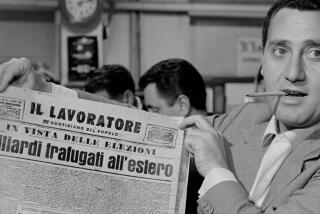FILM : De Sica’s Sad, Honest ‘Umberto’
- Share via
The protagonist of Vittorio De Sica’s “Umberto D” (1952) is an old man with a proud bourgeois streak trying to survive in postwar Italy on a tiny pension. His best friend is a small dog that goes with him everywhere, from his meager apartment to the corner soup kitchen.
If that sounds sentimental, it is. But the film is so clean and direct that there’s no question of mawkishness. De Sica strives for and maintains the quiet tension of realism that keeps it all honest.
“The Bicycle Thief,” made four years earlier and considered De Sica’s most seminal work, may be better known. But “Umberto D,” being shown at UC Irvine Friday night, ranks alongside it. To many, it’s even more affecting because the emotions De Sica manages to reach in us are evoked so purely by Umberto (Carlo Battisti) and the mongrel he calls Flag.
De Sica begins with a street scene typical of his style: The lighting is harsh and realistic, the avenue busy with vaguely nihilistic goings-on. Umberto is with dozens of other old men protesting their small government pensions until the police break up the demonstration. A bit later, the men talk about how a little extra money would set their lives straight.
The focus quickly becomes Umberto, who is in a constant search for funds to pay off his debts and a steady state of depression over his inability to find any. Of many remarkable scenes, a real grabber finds him thinking about becoming a beggar.
As he puts his hand out, testing how it will affect his carefully protected self-respect, a man stops to give him a few lire. But Umberto catches himself, turning his hand palm down, as if he’s checking for rain.
Another outstanding sequence has very little to do with Umberto or even the overall direction of “Umberto D” Cinematographer G.R. Aldo’s camera watches Maria (Maria Pia Casilio), the servant in the boarding house where Umberto lives, as she rises one morning, going through the mundane motions of facing the day. De Sica and Aldo find something ineffable and moving here, as time seems to slow down and our concentration on Maria becomes acute. It’s a famous scene, difficult to explain but easy to savor.
De Sica uses Maria as a contrast to Umberto: Her youthful naivete is set against his stiffening fatalism. Life seems to leave her unaffected (even as she confesses to Umberto that she doesn’t know which of her boyfriends has left her pregnant) but it has begun to degrade Umberto, leading him to thoughts of suicide.
When he tries to find a home for Flag as a prerequisite to that act, it’s a small odyssey both logical and heartbreaking.
As he often did, De Sica turned successfully to non-professionals for his cast. Battisti, a university professor before and after De Sica found him, is remarkable. His uncomplicated approach to a complex character is all instinct and no craft, and does much to convey the quiet but powerful feelings central to the movie.
What: “Umberto D” by Vittorio De Sica.
When: Friday, Nov. 22 at 7 and 9 p.m.
Where: The Crystal Cove Auditorium in UC Irvine’s Student Center.
Whereabouts: Take the San Diego Freeway to Jamboree Road and head south. Turn east onto Campus Drive. Turn onto Bridge Road and onto the campus.
Wherewithal: $2 and $4.
Where to Call: (714) 856-6379.
More to Read
Only good movies
Get the Indie Focus newsletter, Mark Olsen's weekly guide to the world of cinema.
You may occasionally receive promotional content from the Los Angeles Times.








